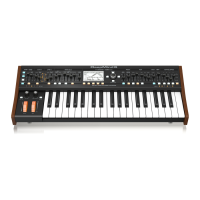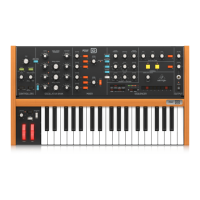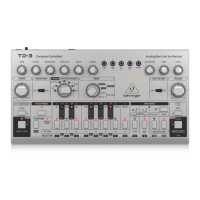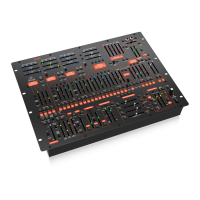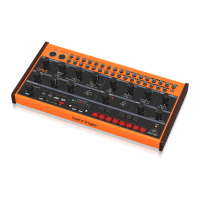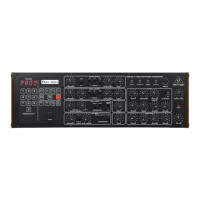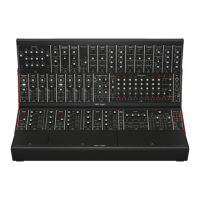62 DeepMind 12 User Manual
• SLEW-RATE - This option allows you to smooth out the transitions of the LFO
waveform. The SLEW RATE reduces the rate of change of the LFO waveform
shape.
The SLEW RATE range is from 0-255, with 0 being no change, and 255 full
smoothing.
The default SLEW RATE setting is 0.
• PHASE - As each voice has independent LFOs, this option allows you to
control the phase relationship between the LFO waveforms.
• POLY - All voices use an independent LFO. This is the default mode.
• MONO - All voices use a common LFO.
• SPREAD - With a setting of 1, there is a 1 degree shift between the LFOs
for each voice. As you begin to increase the SPREAD value, the phase of
the LFO for each consecutive voice will be shifted by the amount of
SPREAD applied. For example, with a 90 degree setting, the rst voice
will always be at 0 degrees, and each consecutive voice will be shifted
by an additional 90 degrees. So with 4 voice UNISON, voice 1 would be
at 0 degrees, voice 2 would be at 90 degrees, voice 3 would be at 180
degrees, and voice 4 would be at 270 degrees.
The PHASE SPREAD range is from 1-254 degrees.
The default PHASE setting is POLY.
5. To exit the LFO EDIT menu, press the EDIT switch again (or press the PROG
switch) to return the main display.
0
85
170
LFO SLEW RATE
255
45
90
180
225
LFO PHASE SPREAD (UNISON 4 SHOWN)
VOICE 1 LFO VOICE 2 LFO VOICE 3 LFO VOICE 4 LFO
8.3 OSC
The Oscillators (OSCs) have a completely analog implementation. The signal path
of the waveform is purely analog circuitry. The pitch of these analog oscillators
is controlled digitally to ensure superior tuning accuracy and stability across the
entire range of playable notes.
• OSC 1 - This dual oscillator generates two dierent waveforms - one
SAWTOOTH, and one SQUARE. The waveforms can be used independently or
together to create harmonically rich content.
Features include pitch modulation of both the sawtooth and square
waveforms, and pulse width modulation of the square waveform.
• OSC 2 - This single oscillator generates a SQUARE waveform.
Features include pitch oset, independent level control, pitch modulation
and tone control modulation of the square waveform.
• NOISE - This generates a NOISE waveform. The NOISE generator is a
completely analog implementation and produces pink noise with a gentle
roll-o of lower frequencies.
8.3.1 OSC 1 PITCH MOD FADER
• The OSC 1 PITCH MOD fader controls the amount of PITCH MODULATION
applied to the OSC1 waveforms. The PITCH MODULATION SOURCE is selected
in the OSC EDIT page described later in this section. Pitch modulation is
often used to create a vibrato eect, but can be used in many other ways.
The range of modulation is very wide, allowing both traditional and creative
modulations.
Controlling the frequency by using an external signal, is a form of frequency
modulation (FM), however as FM is more commonly used to describe the
use of an audio oscillator modulating another audio oscillator, the use of the
term PITCH MODULATION is preferred in this instance.
Note: Because the DeepMind 12 LFO can reach well into the audio range, it
is possible to create traditional frequency modulation (FM) when the LFO is
used as the source for PITCH MODULATION of the OSCs.

